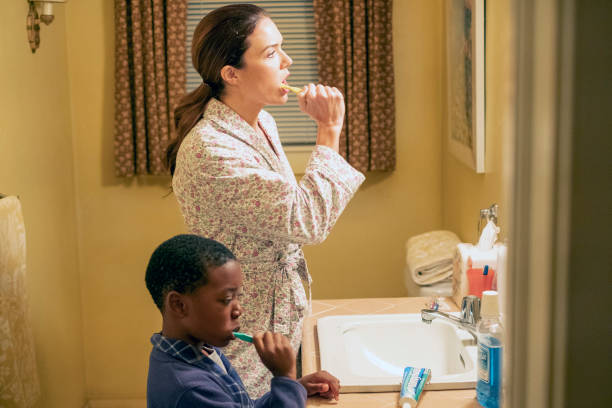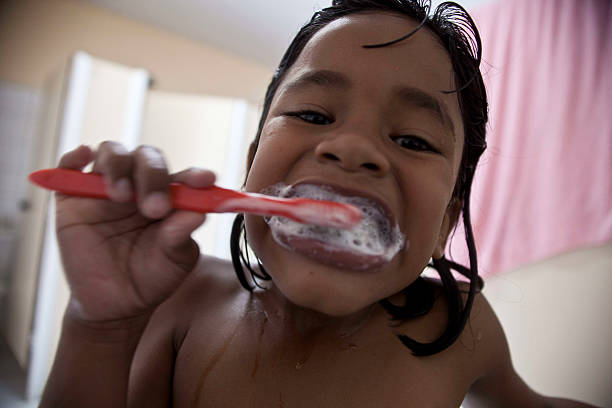
How Often Should My Kids Brush Their Teeth?
Brushing for two minutes twice a day is recommended by the American Dental Association for children.
Cleaning your child’s teeth can be a major chore. For some reason, children seem to be experts at avoiding anything healthy, from vegetables to brushing their teeth. As a result, it is your responsibility as a parent to ensure that they brush their teeth on a regular basis.
How Often Should My Kids Brush Their Teeth?
The main rule for cleaning teeth for youngsters is the same as it is for adults. Twice a day, first thing in the morning and again just before night. It’s also worth noting that the American Dental Association (ADA) suggests brushing your teeth for at least two to three minutes every time.
Toothpaste does not act like soaps or shampoos; simply cleaning your teeth once around the mouth will not enough. Instead, toothpaste functions as a conditioner. As a result, it is critical to take your time and massage the paste into your teeth and gums for it to be effective.
However, we understand that getting your children to brush their teeth twice a day for that long can be difficult. That is why it is critical to make brushing fun for children. There are numerous ways to encourage your children to brush their teeth.
From making brushing a game to rewarding them with star stickers every time they brush. You can even make it more enjoyable by showing them educational children’s programs, preferably about oral hygiene, on a cell phone or tablet.
In any case, it is critical to begin encouraging your children to exercise excellent oral health habits early on so that the habit sticks with them for the rest of their life. It can also help to avoid dental problems such as kid tooth discomfort, cavities, and plaque.
Read More: Baby Teeth vs. Adult Teeth
How can we encourage children to practice good oral hygiene habits?
The first thing a youngster should do when he or she wakes up in the morning is clean their teeth. It is critical to have a regular regimen. Failure to clean for the minimum suggested period might result in major dental issues for the kid later in life.
There are various strategies that parents may employ to ensure that their child spends the appropriate amount of time cleaning their teeth.
Because children frequently imitate their parents, brushing teeth together might be the most motivating.
Playing their favorite songs while brushing their teeth can keep toddlers entertained. It may be difficult for every parent to supervise older children, but going to the bathroom while they brush their teeth can help. Explaining the advantages of cleaning different parts of the teeth is still important.
When it comes to teens, most of them dislike interference because they prefer a certain amount of independence. Offering them an electric toothbrush with a brushing timer may be the best solution.
Baby’s gums and teeth require attention from the moment they appear. The most recommended option for baby’s gums is to clean the area with a piece of cloth. A small amount of fluoride toothpaste and a soft-bristled toothbrush can suffice for a three-year-old.
Which Toothpaste Should My Child Use?
When it comes choosing toothpaste for their children, parents have a plethora of alternatives. The options might be quite daunting. Fluoride toothpaste is recommended for children aged three and up since this component helps to build tooth enamel. We normally recommend a toothpaste made for children under the age of ten since the abrasives contained in adult toothpaste may be too harsh. Most essential, seek for the ADA mark of approval on the toothpaste you choose: this indicates that the product has been tested for safety and efficacy, and that it provides the cavity protection that your kid need.
If you have any questions about which toothpaste to use, consult your dentist. After the age of six, you can also consult your dentist about using an oral rinse for added protection.
Do Children Need Floss?
While brushing usually comes naturally after a little practice, flossing may take a little longer. The American Dental Association recommends that children and adults floss once a day. Children are often unable to floss properly on their own until they are ten or eleven years old, so they will most likely require your assistance. Children can and often prefer to use regular dental floss.
However, some families prefer to start with pre-threaded flossers. The good news is that the ADA says you can floss whenever you want; it doesn’t have to be before or after brushing. If flossing in the mornings or after school is more convenient than before bed when everyone is tired from the day, make it a part of your routine!

When it comes to flossing, setting a good example is just as important as brushing. According to a 2014 ADA survey, only four out of ten American adults floss daily, with 20% never flossing! Make it a part of your own routine so that you can pass on this important oral hygiene step to your children!
If you are interested in more health lifestyle cleaning tips, welcome to read our following posts!
- How To Get Silly Putty Out Of Hair – Painless Ways
- How Long Can You Take a Bath After a New Tattoo?
- How Many Towels You Need – Advice From Expert
- How Long Does Your Hair Have to Be to Wax?
- How To Clean Teeth Without a Toothbrush In Simple Ways
- How to Avoid Dry Socket After Tooth Extraction
- How Much Toothpaste Should You Use?
- How Many Times Can You Bleach Your Hair – Safe Tips
- How To Get Rid Of Buildup From Hair – Easy Ways to Solve
- Why Do I Sweat After a Shower and How to Avoid It?
- 5 Effective Ways to Get Rid of the Gas Smell on Your Hands
- How To Keep Baby’s Room Smelling Fresh: 15 Ways To Fix It!
- Can You Floss Too Much? How Do We Do?





Average Rating